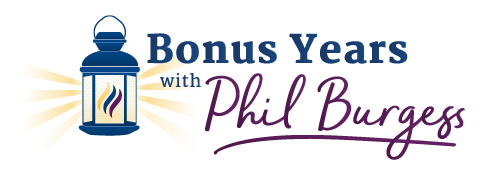
It’s never too late to “refresh,” to be what you want to be
by Phil Burgess, Unabridged from the Life section of the Annapolis Capital, Sunday March 3, 2013
Unabridged from my Bonus Years column in the Lifestyle section of The Sunday Capital, Annapolis, Maryland
During the past two weeks I’ve had conversations and email exchanges with several later-life readers who are embarking on new careers. One had worked 43 years for a large institution with mandatory retirement, and regretted having to step down. He said, “I’m healthy, at the top of my game, and I want to keep working, even if it is on a reduced schedule.”
Two others had become bored with retirement hobbies and activities and wanted to get back into the workplace – in one case on a full-time basis. Still another had pressed the “refresh” button, going back to school to be certified in a new profession, but was having a problem finding a job.
Each of these is an example of an observation by David Corbett, an executive recruiter-turned-later-life-advisor and author: “Americans are coming to realize that the second half of life can mean a second wind…that we are not done at 60, not at 70, and maybe not at 90…[Instead] it’s now a time to serve, a time to learn and try new things. There is much behind, but there is more ahead.”
Theology professor and author Howard Hendricks said much the same thing: ““A person with a calling is a person who has purpose and meaning that will not end with the termination of a job…”
Enter the “second chance,” one of the most distinctive and admirable features of American culture, and one of the most dramatic differences between American culture and those of most other nations. The “second chance” is something you don’t read much about in the “blame America first” malaise that infects so much of what our political and media elites say and write these days, but it may be our most important cultural asset in accounting for America’s exceptional success as a nation.
Americans are great believers in “the second chance.” And the redemptive second chance is built into our earliest practices and basic institutions – practices that didn’t stop with the Mayflower and institutions, like immigration and the community college, that continue to evolve to this day.
Our “second chance” roots are deep. Early 20th century historian, Frederick Jackson Turner observed that the American frontier was advanced by new Americans seeking a second chance and an opportunity for redemption as they headed for the frontier, forsaking extant customs – sometimes even fleeing the law – and creating new institutions (e.g., the circuit-rider judge) and social practices, such as the community barn-raising.
Over time, this “frontier spirit” has been embedded in nearly every aspect of American culture and is reflected in our institutions (e.g., virtual retirement communities, ride-sharing, Craig’s List, Neighborhood Watch) and the ways people treat each other – e.g., the “Welcome Wagon,” food banks, volunteerism and philanthropic giving.
One of the best examples of the “second chance” is, of course, immigration and the many paths to citizenship we provide to those not born here.
Another is education, which, at least until recently, has been the product of citizen-leaders, decentralized flexibility that can reflect the changing needs of students and society and new possibilities created by new technologies – from the old overhead projector to iPads. These virtues created some pretty good results during most of the past 150 years or so.
America is unique in this important way: Our institutions and practices recognize that the intellectual and social development of individuals varies widely from person to person just as their intellectual and social needs change over time. Early on, mid-career or (increasingly) in retirement, many Americans decide to go back to school to earn a professional or technical degree – for example, at the community college, a hugely-successful American innovation where adult and continuing education are an important part of its mission, or at a proprietary (i.e., for-profit) school, like the University of Phoenix, Kaplan, or DeVry University.
How many people didn’t do well through high school but “caught fire” in college – or at the community college and then went on to the four-year institution only to graduate, sometimes with honors – and then, mid-career, took an advanced degree in business, public administration, or some other professional discipline. In fact, it happens all the time in America.
America is not just the land of the “second chance.” It is the land of the third and fourth and fifth chance. And the sixth and seventh. America is the land of redemption, where, compared to other countries, it’s hard (not impossible, but difficult) to get “slotted” by the system and then “written off” – unlike the UK, Japan and other cultures where national, standardized tests often determine a young person’s future by the time he or she is 12 years old, based on tests given in the 6th grade. And opportunities for mid-career and later-life corrections are limited.
Indeed, America brings to life the words of Victorian novelist, Mary Anne Evans, better known as George Eliot, “It is never too late to be what you might have been.”
In America, there are nearly unlimited opportunities to make a “mid-course adjustment” or even to start over at any stage of life. Indeed, the idea of starting over is hard-wired into our cultural DNA, and it doesn’t stop with the young. The idea and practice of the “second chance” also extends into later-life, if we just take advantage of our freedom to review our gifts, explore new on-the-clock options and then take the leap into a new career – whether it is paid work or volunteer work, full time or part time.
Finding a way to continue to remain engaged when your career is over but your life isn’t is increasingly on the agenda of later-life Americans. That well-known philosopher, Erma Bombeck, perhaps said it best: “When I stand before God at the end of my life, I would hope that I would not have a single bit of talent left, and could say, ‘I used everything you gave me.’”
Get the Bonus Years column right to your inbox
We take your inbox seriously. No ads. No appeals. No spam. We provide — and seek from you — original and curated items that make life in the Bonus Years easier to understand and easier to navigate.
